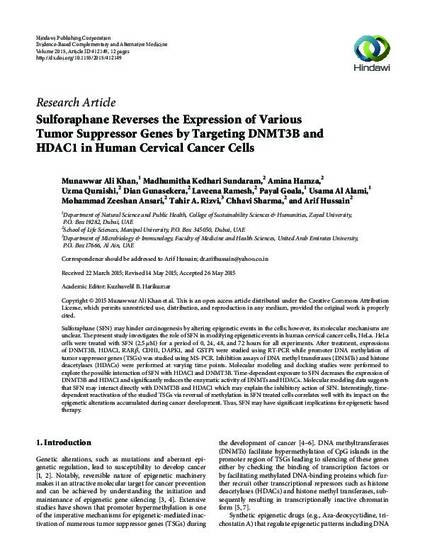
© 2015 Munawwar Ali Khan et al. Sulforaphane (SFN) may hinder carcinogenesis by altering epigenetic events in the cells; however, its molecular mechanisms are unclear. The present study investigates the role of SFN in modifying epigenetic events in human cervical cancer cells, HeLa. HeLa cells were treated with SFN (2.5 μM) for a period of 0, 24, 48, and 72 hours for all experiments. After treatment, expressions of DNMT3B, HDAC1, RARβ, CDH1, DAPK1, and GSTP1 were studied using RT-PCR while promoter DNA methylation of tumor suppressor genes (TSGs) was studied using MS-PCR. Inhibition assays of DNA methyl transferases (DNMTs) and histone deacetylases (HDACs) were performed at varying time points. Molecular modeling and docking studies were performed to explore the possible interaction of SFN with HDAC1 and DNMT3B. Time-dependent exposure to SFN decreases the expression of DNMT3B and HDAC1 and significantly reduces the enzymatic activity of DNMTs and HDACs. Molecular modeling data suggests that SFN may interact directly with DNMT3B and HDAC1 which may explain the inhibitory action of SFN. Interestingly, time-dependent reactivation of the studied TSGs via reversal of methylation in SFN treated cells correlates well with its impact on the epigenetic alterations accumulated during cancer development. Thus, SFN may have significant implications for epigenetic based therapy.
- death associated protein kinase,
- death associated protein kinase 1,
- DNA methyltransferase 3B,
- fizzy related protein,
- glutathione transferase P1,
- histone deacetylase,
- histone deacetylase 1,
- retinoic acid receptor beta,
- sulforaphane,
- unclassified drug,
- Article,
- controlled study,
- DNA methylation,
- drug mechanism,
- enzyme activity,
- female,
- gene expression,
- gene targeting,
- HeLa cell line,
- human,
- human cell,
- molecular docking,
- molecular model,
- priority journal,
- promoter region,
- reverse transcription polymerase chain reaction,
- tumor suppressor gene
Available at: http://works.bepress.com/munawwar-khan/22/